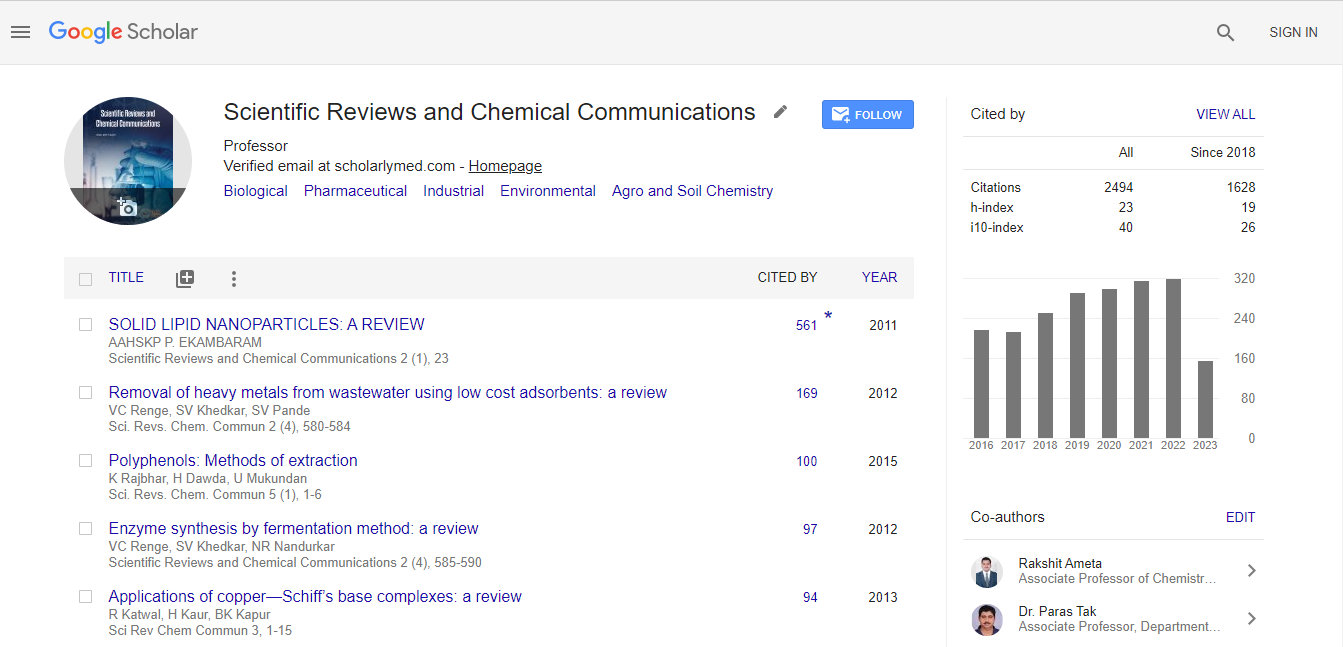Review
, Volume: 12( 3)A Facile Approach to Creating Sensitive and Selective Cu(II) Sensors on Carbon Fiber Microelectrodes
- *Correspondence:
- Irina S. Joseph Associate Professor, Ullswater Avenue, West End Southampton, Hampshire UK, E-mail: chemcommun@scholarlymed.com
Received date: 07-July-2023, Manuscript No. tssrcc-23-109457; Editor assigned: 10-July-2023, PreQC No. tssrcc-23-109457(PQ); Reviewed: 12-July-2023, QC No. tssrcc-23-109457(Q); Revised: 17-July-2023, Manuscript No. tssrcc-23-109457(R); Published: 27-July-2023, DOI. 10.37532/2277-2669.2023.12(3).17-19
Citation: Joseph I S. A Facile Approach to Creating Sensitive and Selective Cu(II) Sensors on Carbon Fiber Microelectrodes.2023;12(3):17-19. ©2023 Trade Science Inc
Abstract
The identification and measurement of Cu(II) ions in different environmental, biological, and industrial samples are highly crucial owing to their potentially harmful effects and wide distribution. To address this issue, this review article delves into an innovative and straightforward approach for creating sensitive and selective Cu(II) sensors using carbon fiber microelectrodes. By combining carbon fiber microelectrodes with specific ligands or functional materials, a promising platform has emerged for rapid, accurate, and on-site detection of Cu(II). This article provides a comprehensive examination of the underlying principles, fabrication methods, and performance characteristics of these sensors, emphasizing their potential applications and future possibilities. The integration of carbon fiber microelectrodes with selective ligands or materials offers a promising solution for detecting Cu(II) in various samples, facilitating its monitoring and contributing to the understanding and management of its’ potential toxic effects in the environment and living organisms. Moreover, these sensors hold the potential to be utilized in diverse industrial settings for monitoring Cu(II) levels, ensuring safety, and preventing potential contamination. Looking ahead, further research and development in this area could lead to even more advanced and versatile Cu(II) sensors, with broader applications and enhanced sensitivity, ultimately benefiting environmental and human health.
Keywords
Quantum information, Neutron cavity, Dynamical diffraction, Neutron interferometry
Introduction
The detection and quantification of Cu(II) ions in a variety of contexts, such as the environment, biology, and industry, are of utmost importance due to their widespread presence and potential harm. To address this critical concern, this review article explores a novel and uncomplicated method for crafting Cu(II) sensors with high sensitivity and selectivity, utilizing carbon fiber microelectrodes. By combining these microelectrodes with specific binding agents or functional materials, a promising platform emerges that enables swift, accurate, and real-time identification of Cu(II) on location [1].
This article offers a thorough exploration of the fundamental principles, manufacturing techniques, and performance attributes of these sensors, with a strong emphasis on their potential applications and future prospects. The fusion of carbon fiber microelectrodes with specialized binding agents or materials presents an encouraging solution for detecting Cu(II) in diverse sample types. This innovation aids in monitoring Cu(II) levels and contributes to a better understanding and management of its potential toxic consequences in both the environment and living organisms
Furthermore, these sensors exhibit significant potential for deployment across various industrial settings, ensuring vigilant monitoring of Cu(II) concentrations to prevent potential contamination and guarantee safety [2]. As we look forward, continued research and advancement in this domain have the potential to yield even more advanced and versatile Cu(II) sensors. These improved sensors could offer broader applicability and heightened sensitivity, ultimately leading to benefits for both environmental preservation and human well-being.
Literature Review
Carbon fiber microelectrodes
Carbon fiber microelectrodes have become increasingly favored in the realm of electrochemical sensing due to their distinctive characteristics, including a substantial surface area, minimal intrinsic noise, and swift electron transfer kinetics. In this discourse, we delve into the methods employed for creating and augmenting carbon fiber microelectrodes, with the aim of optimizing their efficacy in detecting Cu(II) ions.
Ligands and functional materials
Enhancing the effectiveness of Cu(II) sensors can be achieved through the integration of specialized ligands or functional materials onto the surface of carbon fibers [3]. In our assessment, we examine a range of ligands, including chelating agents, ionophores, and organic compounds, all of which have demonstrated remarkable proficiency in binding with Cu(II). Furthermore, we delve into the application of nanomaterials, such as nanoparticles and metal-organic frameworks, as coatings on carbon fibers. This exploration aims to advance the capabilities of Cu(II) sensing by augmenting sensitivity and selectivity.
Electrochemical techniques
Various electrochemical methods, such as cyclic voltammetry, differential pulse voltammetry, and amperometry, have been utilized to detect the presence of Cu(II) using microelectrodes made from carbon fiber. In this discussion, we delve into the strengths and drawbacks of each of these techniques, assessing how well they align with specific intended uses and applications.
Performance evaluation
Quantum error correction is a pivotal aspect of quantum computing and quantum information processing. Its application to neutron cavities could mitigate the effects of de-coherence, improve the reliability of experiments, and enable longer coherence times. We delve into potential quantum error correction schemes tailored for neutron-based systems.A comprehensive assessment of the effectiveness of copper ion (Cu(II)) sensors utilizing carbon fiber microelectrodes is provided encompassing sensitivity, selectivity, detection limit, and response time. By comparing these sensors with alternative existing techniques, this study highlights the exceptional capabilities of the proposed method. The results indicate that the Cu(II) sensors based on carbon fiber microelectrodes exhibit superior performance, demonstrating enhanced sensitivity, selectivity, lower detection limits, and faster response times when compared to other methods currently in use [4]. This research contributes valuable insights into the advancement of sensor technology for detecting Cu(II) and underscores the potential of carbon fiber microelectrodes in analytical applications.
Applications
The utilization of copper ion (Cu(II)) sensors integrated into microelectrodes made of carbon fiber has been examined across diverse domains including environmental surveillance, food quality assessment, and medical diagnostics. This discussion sheds light on the adaptability of such sensors and underscores their importance in real-world scenarios through specific instances and empirical illustrations. These examples underscore the tangible and significant role these sensors play in practical applications [5,6]
Challenges and future perspectives
We acknowledge the existing difficulties and possible constraints inherent in the suggested methodology. Additionally, we put forth avenues for forthcoming investigations, encompassing the incorporation of advancing technologies such as artificial intelligence and microfluidics. These innovations hold the potential to bring about a transformative shift in the field of Cu(II) sensing.
Conclusion
In summary, the direct approach to creating Cu(II) sensors using carbon fiber microelectrodes not only offers a convenient method but also has the potential to surpass traditional techniques in detecting Cu(II) ions. The unique characteristics of carbon fiber microelectrodes, combined with carefully crafted ligands and functional materials, establish a robust basis for accurate and rapid analysis of Cu(II) ions. The ongoing exploration and refinement in this field show significant promise in addressing the environmental and health concerns arising from Cu(II) contamination. This innovative strategy presents an optimistic path for advancing the identification and mitigation of Cu(II) presence. By harnessing the capabilities of carbon fiber microelectrodes and innovative molecular design, this approach holds great potential for revolutionizing the detection and management of Cu(II) ions.
References
- D'Ambrosi N, Rossi L. Copper at synapse: Release, binding and modulation of neurotransmission. Neurochem int. 2015;90:36-45.
- Harkany T, Abraham I, Timmerman W, et al. β‐Amyloid neurotoxicity is mediated by a glutamate‐triggered excitotoxic cascade in rat nucleus basalis. Eur. J. Neurosci. 2000;12(8):2735-45.
- Parameshwaran K, Dhanasekaran M, Suppiramaniam V. Amyloid beta peptides and glutamatergic synaptic dysregulation. Exp. Neurol. 2008;210(1):7-13.
- Bagheri S, Squitti R, Haertlé T, et al. Role of copper in the onset of Alzheimer’s disease compared to other metals. Front aging neurosci. 2018;9:446.
- Eskici G, Axelsen PH. Copper and oxidative stress in the pathogenesis of Alzheimer’s disease. Biochemistry. 2012;51(32):6289-11.
- Huang X, Atwood CS, Moir RD, et al. Trace metal contamination initiates the apparent auto-aggregation, amyloidosis, and oligomerization of Alzheimer’s Aβ peptides. JBIC J Biol Inorg Chem. 2004;9:954-60.

